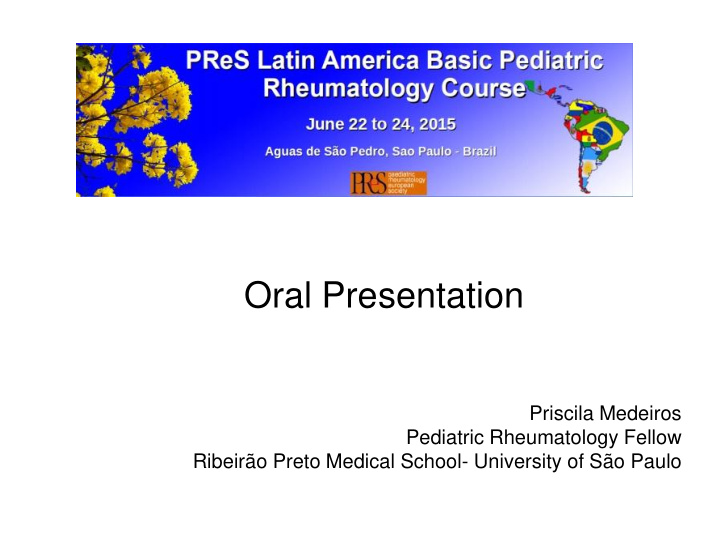



Oral Presentation Priscila Medeiros Pediatric Rheumatology Fellow Ribeirão Preto Medical School- University of São Paulo
Id Identification 3 year-old, mullato, Brazilian boy First appointment: May/06/2010 Main complaints : Fever, pallor and skin lesions since 3 months of age History : Persistent daily fever (39 o C) since 3 months of age, associated with pallor, apathy, irritability and failure to thrive. In addition, he presented erythematous cutaneous lesions initially over the face, progressing to trunk, abdomen, arms and legs. Family history: Parents were first-degree cousins Single child No similar cases in the family
Physic ical examin ination Positive findings: • Dysmorphic face (saddle nose, thicker lips, undefined filter, lipodistrophy) • Multiple indurated erythemato violaceous skin lesions • Periorbital and limb swelling • Subcutaneous nodules • Lymphadenopathy • Hepatosplenomegaly • Bony overgrowth of May 10 PIP joints and knees • Limping gait
Laboratory fin findin ings May 10 Nov 10 Fev 11 Hb / Ht 7 g/dl/ 23% 9 g/dl/ 29% 8,3 g/dl/ 27% WBC 6 400/µL 3 000/µL 3 300/µL Lym 1 472/µL 1 080/µL 1 452/µL Plat 216 000/µL 206 000/µL 302 000/µL CRP 16,9 mg/dl 6,48 mg/dl -- ESR 62 mm 40 mm 58 mm LDH 1045 U/L -- -- Ferritin 899 ng/ml -- -- IgG 2 250 mg/dl (>p97 ) -- -- IgA 297 mg/dl (>p97) -- -- IgM 149 mg/dl (>p97) -- -- AST/ALT 25/06 FA/GGT 574/93
Laboratory ry and bio iopsyf yf in indings • Negative autoantibodies • Investigation for virus (CMV,EBV, HERPES,PARVOVIRUS), bacteria (blood, urine and liquor culture ) and fungus infection was negative • Inborn errors of metabolism were discarded Skin biopsy: Dermal histiocytic infiltration associated with some mononuclear cells. Immunofluorescence CD 68+ Liver biopsy: Mild fibrosis peri central vein and microgoticular steatosis
Previo ious dia iagnosis • Jul 2008 First diagnosed as Sweet’s síndrome in another centre, received corticosteroid and dapsone for 16 months, with no improvement • Nov 2009 The diagnosis was revised, and NOMID (Neonatal Onset Multisystem Inflammatory Disease) hypothesis was made. Methotrexate was associated to the treatment for 6months, without any improvement.
Foll llow up up • May 2010- First appointment at our service. • Aug 2010- After thalidomide was introduced, fever and edema improved; no new cutaneous lesions appeared. • Feb 2011- Due to drowsiness and appearance of new lesions, thalidomide was changed for colchicine • Mar 2011- patient did not return to our centre • June 2012- we received the information that this boy had died at 4 years old in march 11, after a sudden episode of vomiting and seizures.
Genetic ic analy lysis is • Jan 2011: CIAS1 gene: no mutations on exons 1 to 9 “Hereditary autoinflamatory syndromes: a Brazilian multicentre study” - Jesus AA at all • March 2012: PSMB8 gene : homozygous T75M mutation performed at NIH Lab for Adriana de Jesus, MD • Final diagnosis: CANDLE syndrome (Chronic Atypical Neutrophilic Dermatosis with Lipodystrophy and Elevated Temperature).
Questions to the audience How can we treat a patient with undefined autoinflammatory syndrome without genetic study? What else could be used to treat this patient?
Thank you
Recommend
More recommend